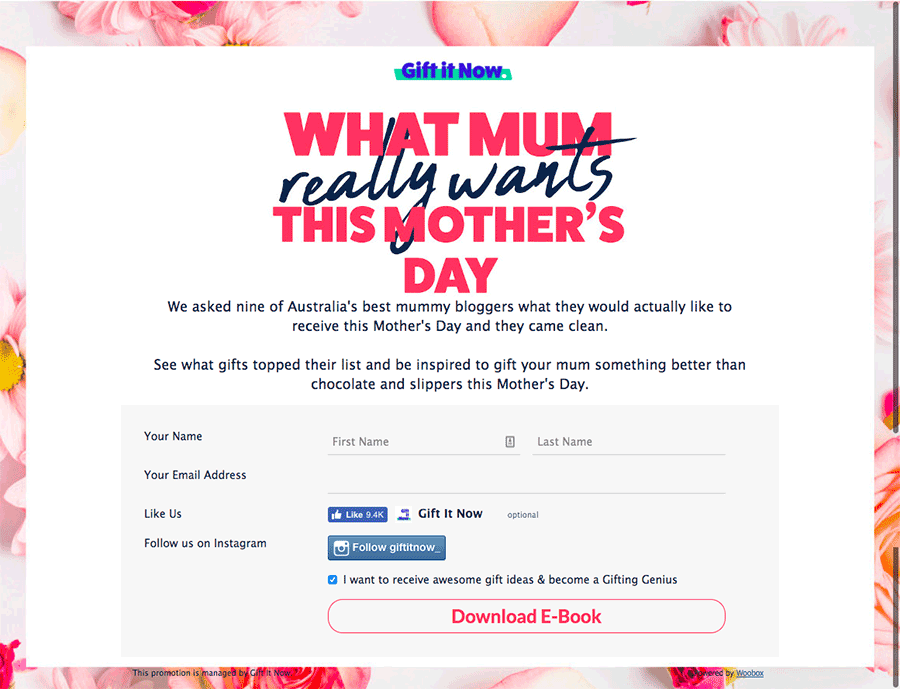You created the perfect ad copy, creative that wows, and the most enticing offering, but your conversion rate isn’t reflecting your effort. It could mean you need to go back and rework your ads, but more often than not, poor conversions could be resulting from the landing page your ads are directing your ad traffic to.
Many marketers miss this final piece of the puzzle and end up derailing their entire campaigns. Don’t let this be you! A direct response landing page is the place where you clearly communicate your value-add and tactfully convince a user in a short period of time to download the ebook, sign up for the webinar, or purchase the product.
And even better news, you don’t need expensive lead page software, because the key is in the copy. You can easily create high converting landing pages using affordable and versatile software like Woobox to create your campaign from ad to thank you page.
So how do you create landing pages that support and increase your campaign conversion rate? This article will cover the 5 non-negotiable foundations for landing page effectiveness.
1. Start with a clear understanding of your ideal customer
In the most straightforward explanation, a converting landing page speaks directly to the interests of your target audience, using the language they use. A landing page that’s effective will simultaneously filter out leads irrelevant to your product or service offering. To do this, you need to have a thorough understanding of the audience and create detailed customer profiles to base your page message and language around.
You can do this by surveying existing clients, putting together a focus group, or even on discovery calls with new clients. Another powerful and free tool to learn specific insights about your target audience is Facebook Audience Insights, which you can learn how to use in this article. If this step isn’t completed accurately, your landing page will not work.
2. All copy on the page should focus on one goal
Every single piece of copy and imagery on the landing page should focus on the purpose of the landing page. For example, if your landing page has a goal of lead capture by getting as many downloads as possible for an eBook, the headline and sub-headline will tell you what the eBook is about and the problem it will solve. The imagery will guide your eyes towards the download button, and even every CTA will be focused on getting the download.
Here is a minimalistic example from a Woobox user that follows this point.

Notice how every headline, description, and button focuses on and supports the goal of downloading the eBook. The rule of thumb, if it doesn’t relate to your main goal, scrap it.
3. Let the user know immediately that they are in the right place
When someone lands on your page from one of your ads, they should experience immediate confirmation that they are in the right place through what is called your unique value proposition.
The unique value proposition (or UVP) needs to be clear and concise, dissecting the page offering down to its most basic level and highlighting benefits that matter to the user. They know they are in the right place if your page offer is related to and solves what they were looking for when they clicked on your ad. On a basic landing page, your value proposition is comprised of the following elements: a headline, a subheadline, a reinforcing statement, and a closing argument.
Let’s dive deeper into the headline and subheadline for the purposes of this article.
Headline and SubHeadline
The most concise and powerful expression of how your product or service is different should exist in the landing page headline and subheadline. The headline will be the first thing visitors see and it should clearly describe what the visitor will get from the website. It should be short and impactful.
For example, “Design Better Products, Faster” or “We Can Help You Get Out of Debt”. The subheadline should be a phrase that further clarifies the primary headline, or can be used as an extension of the header.
When coming up with a headline and subheadline, here are some clarifying questions to ask during brainstorming.
- Am I 100% confident this headline will stop visitors in their tracks?
- Is the headline less than 12 words?
- Are SEO keywords included naturally?
- Am I asking a question or making a bold statement?
- Is my subheadline a power-packed supporting line?
4. Overcome any objections the visitor has, and give them a friendly nudge
Just like closing any sale, you need to address the concerns and objections a potential client might have. To do this you need to anticipate their hesitations and directly address each, one by one, in the body text of your landing page. On a landing page, you take the answers to potential objections and turn them into the compelling reasons, examples, and testimonials that ease any potential worry, and instill trust that visitors are making a sound purchase or download.
Overcoming objections to persuade a purchase or download can also be enhanced by something called “click triggers,” which are essentially a nudge. These are key phrases that give the visitor a poke to fulfill the goal action of your landing page, while simultaneously easing worry from objections.
For example, a common click trigger is “Money Back Guarantee.” This simple phrase reassures the user that if they’re unsatisfied they have no risk of loss, significantly amplifying the chances a visitor will take an action benefiting your business and brand. Remember that strong click triggers are important because they ultimately lead to many more considerations and conversions. Without them, you will experience far fewer conversions because the visitor is left to decide whether or not to take action on their own.
5. Finally, you must instill trust
Here is a very important question to keep in mind when crafting copy for your landing page: Why should the visitor believe you?
With scams spanning the internet like digital plagues, it’s more important than ever to prove that what you’re offering actually does what it says and that you are a trustworthy business. Copy elements that help to build trust include things like press, ratings, test results, reviews, and testimonials. Make sure to sprinkle these trust elements throughout the entirety of the landing page, and reinforce them at the very end of the page.
You can get even more strategic by inserting testimonials that relate to what we previously covered: objections and worries. Put your testimonials to work for you, and use third-party advocates to edify your product claims and build deeper trust with each landing page visitor.
Conclusion
What’s most important to launch an effective landing page is the copy and accurate, relevant messaging. One last tip: whatever you do, under any circumstances, do not send your ad traffic to your website homepage unless your only goal is to increase your web traffic. Landing pages provide your visitor exactly what they are looking for, and most importantly, they avoid wasting a visitor’s time and captures their very short attention span window.
It’s simple to add landing pages to your ad strategy with Woobox, with no additional cost for unnecessary lead page software. A Woobox account is free to start building campaigns, and users can make as many giveaways, contests, and campaigns as they like. A paid Woobox subscription is only needed to publish and run new campaigns.
